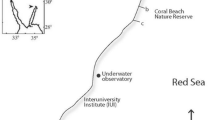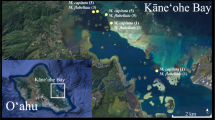Abstract
The type and frequency of reproduction of three common sponge species was monitored histologically and by direct field observations of spawning events over 2 successive years at the reefs of Curaçao.
Ircinia strobilina showed year round reproductive activity by the production of spermatic cysts in varying intensities in a major part of the population. Production of oocytes and larvae were only observed in the period from September through April, indicating an actual breeding season of 8 months a year. The sexes in this viviparous sponge seem to be separate, but protandry cannot be ruled out. Less than 10% of the sponge tissue was found to consist of reproductive elements.
Neofibularia nolitangere is a gonochoristic oviparous sponge with a short annual breeding season of 2 months, in which two successive, highly predictable, short spawning periods occurred synchronously for the whole population. Up to half of the sponge tissue was transformed to reproductive elements.
Agelas clathrodes showed low reproductive activity. Field observation suggests that this sponge is an oviparous hermaphrodite, probably annually releasing male and female gametes synchronously in a varying number of individuals of its population during a short breeding period.
The variation in reproductive patterns in this small group of large massive coral reef sponges spans a range similar to that found in the morphologically highly variable group of stony corals and illustrates their ecological differentiation on the reef.
Similar content being viewed by others
References
Ayling AL (1980) Patterns of sexuality, asexual reproduction and recruitment in some subtidal marine Demospongiae. Biol Bull 158:271–282
Babcock RC, Bull GD, Harrison PL, Heyward AJ, Oliver JK, Wallace CC, Willis BL (1986) Synchronous spawnings of 105 scleractinian coral species on the Great Barrier Reef. Mar Biol 90:379–394
Bak RPM (1977) Coral reefs and their zonation in Netherlands Antilles. Am Assoc Pet Geol Stud Geol 4:3–16
Benayahu Y, Loya Y (1984) Life history studies on the Red Sea soft coral Xenia macrospiculata Gohar, 1940. II. Planulae shedding and post larval development. Biol Bull 166:44–53
Bergquist PR, Sinclair ME (1973) Seasonal variation in settlement and spiculation of sponge larvae. Mar Biol 20:35–44
Bergquist PR, Sinclair ME, Green QQ, Silyn-Roberts H (1979) Comparative morphology and behaviour of larvae of Demospongiae. In: Lévi C, Boury-Esnault N (eds) Biologie des Spongiaires. Colloques Internationaux du C.N.R.S., Paris, pp 103–111
Brien P (1973) Les demosponges. Morphologie et reproduction. In: Grassé PP (ed) Traité de zoologie, vol 3. Masson, Paris, pp 133–461
Charnov EL (1982) The theory of sex allocation. Princeton University Press, Princeton, NJ
Fell PE (1974) Porifera. In: Giese AC, Pearse JS (eds) Reproduction of marine invertebrates. Academic Press, New York London, pp 51–132
Fell PE (1983) Porifera. In: Adiyodi KG, Adiyodi RG (eds) Reproductive biology of invertebrates, vol 1: Oogenesis, oviposition and oosorption. Wiley, Chichester, pp 1–29
Fell PE, Parry EH, Balsamo AM (1984) The life histories of sponges in the Mystic and Thames estuaries (Connecticut), with emphasis on larval settlement and post larval reproduction. J Exp Mar Biol Ecol 78:127–141
Grigg RW (1977) Population dynamics of two gorgonian corals. Ecology 58:278–290
Harriott VJ (1983) Reproductive ecology of four scleractinian species at Lizard Island, Great Barrier Reef. Coral Reefs 2:9–18
Harrison PL, Babcock RC, Bull GD, Oliver JK, Wallace CC, Willis BL (1984) Mass spawning in tropical reef corals. Science 223:1186–1189
Hoek C van den, Breeman AM, Bak RPM, Buurt G van (1978) The distribution of algae, corals and gorgonians in relation to depth, light attenuation, water movement and grazing pressure in the fringing coral reef of Curaçao, Netherlands Antilles. Aquat Bot 5:1–46
Hoppe WF, Reichert MJM (1987) Predictable annual mass release of gametes by the coral reef sponge Neofibularia nolitangere (Porifera, Demospongiae). Mar Biol 94:277–286
Jackson JBC (1979) Morphological strategies of sessile animals. In: Larwood G, Rosen BR (eds) Biology and systematics of colonial organisms. Academic Press, London New York, pp 499–555
Kojis BL, Quinn NJ (1982a) Reproductive ecology of two faviid corals (Coelenterata: Scleractinia). Mar Ecol Prog Ser 8:251–255
Kojis BL, Quinn NJ (1982b) Reproductive strategies in four species of Porites (Scleractinia). Proc 4th Int Coral Reef Symp 2:145–151
Lévi C (1957) Ontogeny and systematics in sponges. Syst Zool 6:174–183
Lévi C, Lévi P (1976) Embryogenèse de Chondrosia reniformis (Nardo), Démosponge ovipare, et transmission des bactéries symbiotique. Ann Sci Nat Zool Biol Anim 18:367–380
Lewis JB (1974) The settlement behaviour of planulae larvae of the hermatypic coral Favia fragum (Esper). J Exp Mar Biol Ecol 15:165–172
Moorsel GWNM van (1983) Reproductive strategies in two closely related story corals (Agaricia, Scleractinia). Mar Ecol Prog Ser 13:273–283
Reiswig HM (1973) Population dynamics of three marine Demosponges. Biol Bull 141:568–591
Reiswig HM (1976) Natural gamete release and oviparity in Caribbean Demospongiae. In: Harrison HW, Cowden RR (eds) Aspects of sponge biology. Academic Press, New York, pp 99–112
Reiswig HM (1983) Porifera. In: Adiyodi KG, Adiyodi RG (eds) Reproductive biology of invertebrates, vol 2: Spermatogenesis and sperm function. Wiley, Chichester, pp 1–21
Rinkevich B, Loya Y (1979a) The reproduction of the Red Sea coral Stylophora pistillata. I. Gonads and planulae. Mar Ecol Prog Ser 1:133–144
Rinkevich B, Loya Y (1979b) The reproduction of the Red Sea coral Stylophora pistillata. II. Synchronization in breeding and seasonality in planulae shedding. Mar Ecol Prog Ser 1:145–152
Shlesinger Y, Loya Y (1985) Coral community reproductive patterns: Red Sea vs Great Barrier Reef. Science 228:1333–1335
Simpson TL (1980) Reproductive process in sponges: a critical evaluation of current data and views. Int J Inv Reprod 2:251–269
Stimson JS (1978) Mode and timing of reproduction in some common hermatypic corals of Hawaii and Enewetak. Mar Biol 48:173–184
Storr JF (1964) Ecology of the Gulf of Mexico commercial sponges and its relation to the fishery. US Fish Wildl Ser Spec Sci Rep 466:1–73
Szmant AM (1986) Reproductive ecology of Caribbean reef corals. Coral Reefs 5:43–54
Warburton FE (1961) Inclusion of parental somatic cells in sponge larvae. Nature 191:1317
Author information
Authors and Affiliations
Rights and permissions
About this article
Cite this article
Hoppe, W.F. Reproductive patterns in three species of large coral reef sponges. Coral Reefs 7, 45–50 (1988). https://doi.org/10.1007/BF00301981
Accepted:
Issue Date:
DOI: https://doi.org/10.1007/BF00301981




